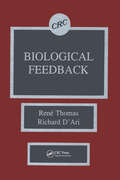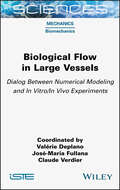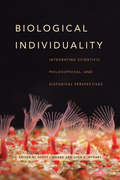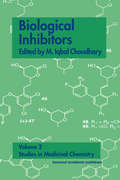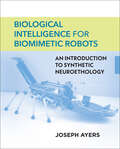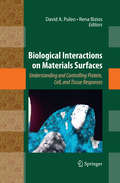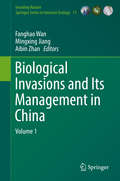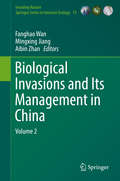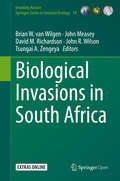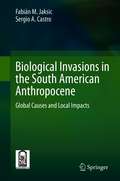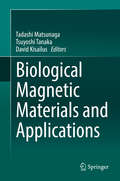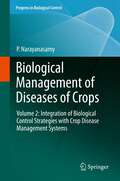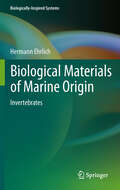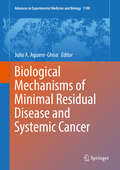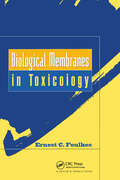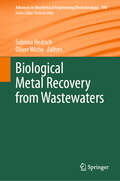- Table View
- List View
Biological Evolution: An Introduction
by Mike CassidyBiological evolution, the theory of natural selection and of common descent, is a triumph both of human reasoning and scientific undertaking. The biological discipline of evolution contains both a chronicle of human endeavour and the story of life on Earth. This book is concerned with living forms and how they developed from 'simple and unpromising beginnings'. It considers evolution as both process and product. The author, an experienced teacher and educator, employs a historical narrative, used to convey the idea of 'change with modification' and to emphasise the relevance of evolution to contemporary bioscience. Biological evolution has now become part of the scientific orthodoxy and this accessible text will assist undergraduate students in the biological sciences within any ongoing debate.
Biological Feedback
by Rene Thomas Richard D'AriClearly explaining the logical analysis of biological control phenomena, Biological Feedback answers questions concerning everything from regulation to logic. This rare monograph presents a formal methodology for analyzing the dynamic behavior of complex systems. The easy-to-read text describes a simple logical formalization called "kinetic logic". The reader discovers how this method is used to predict all possible patterns of behavior of which a system is capable. It includes specific conditions required for each pattern. It also explains how to modify an incorrect model in order to account for the observed behavior. The authors give special attention to the two basic types of simple feedback loops: positive and negative. This volume is filled with easy-to-use tables, providing quick reference throughout the book. The subject matter is of great interest to everyone working in molecular genetics and developmental biology. Researchers, immunologists, physical chemists, physicists, electrical engineers, economists, and mathematicians will find this unique text to be an informative, indispensable resource.
Biological Field Emission Scanning Electron Microscopy (RMS - Royal Microscopical Society)
by Roland A. Fleck Bruno M. HumbelThe go‐to resource for microscopists on biological applications of field emission gun scanning electron microscopy (FEGSEM) The evolution of scanning electron microscopy technologies and capability over the past few years has revolutionized the biological imaging capabilities of the microscope—giving it the capability to examine surface structures of cellular membranes to reveal the organization of individual proteins across a membrane bilayer and the arrangement of cell cytoskeleton at a nm scale. Most notable are their improvements for field emission scanning electron microscopy (FEGSEM), which when combined with cryo-preparation techniques, has provided insight into a wide range of biological questions including the functionality of bacteria and viruses. This full-colour, must-have book for microscopists traces the development of the biological field emission scanning electron microscopy (FEGSEM) and highlights its current value in biological research as well as its future worth. Biological Field Emission Scanning Electron Microscopy highlights the present capability of the technique and informs the wider biological science community of its application in basic biological research. Starting with the theory and history of FEGSEM, the book offers chapters covering: operation (strengths and weakness, sample selection, handling, limitations, and preparation); Commercial developments and principals from the major FEGSEM manufacturers (Thermo Scientific, JEOL, HITACHI, ZEISS, Tescan); technical developments essential to bioFEGSEM; cryobio FEGSEM; cryo-FIB; FEGSEM digital-tomography; array tomography; public health research; mammalian cells and tissues; digital challenges (image collection, storage, and automated data analysis); and more. Examines the creation of the biological field emission gun scanning electron microscopy (FEGSEM) and discusses its benefits to the biological research community and future value Provides insight into the design and development philosophy behind current instrument manufacturers Covers sample handling, applications, and key supporting techniques Focuses on the biological applications of field emission gun scanning electron microscopy (FEGSEM), covering both plant and animal research Presented in full colour An important part of the Wiley-Royal Microscopical Series, Biological Field Emission Scanning Electron Microscopy is an ideal general resource for experienced academic and industrial users of electron microscopy—specifically, those with a need to understand the application, limitations, and strengths of FEGSEM.
Biological Flow in Large Vessels: Dialog Between Numerical Modeling and In Vitro/In Vivo Experiments
by Valerie Deplano Jose-Maria Fullana Claude VerdierThis book examines recent methods used for blood flow modeling and associated in vivo experiments, conducted using experimental data from medical imaging. Different strategies are proposed, from smallscale models to complex 3D modeling using modern computational codes. The geometries are wide-ranging and deal with the narrowing and widening of sections (stenoses, aneurysms), bifurcations, geometries associated with prosthetic elements, and even cases of vessels with smaller dimensions than those of the blood cells circulating in them.Biological Flow in Large Vessels provides answers to the question of how medical and biomechanical knowledge can be combined to address clinical problems. It offers guidance for further development of numerical models, as well as experimental protocols applied to clinical research, with tools that can be used in real-time and at the patient’s bedside, for decision-making support, predicting the progression of pathologies, and planning personalized interventions.
Biological Functions for Information and Communication Technologies: Theory and Inspiration (Studies in Computational Intelligence #320)
by Hidefumi SawaiBy incorporating biologically-inspired functions into ICT, various types of new-generation information and communication systems can be created. Just some example of areas already benefiting from such design inspiration are network architectures, information processing, molecular communication, and complex network modeling for solving real world-problems. This book provides the theoretical basis for understanding these developments and explains their practical applications. Highlighted inserts appears throughout to help readers to understand the very latest topics in these emerging research fields. The book ends with a more philosophical discussion on how new ICT solutions can be found by looking at analogous systems in biology. This new way of thinking may help researchers and practitioners to apply innovative ideas in developing next-generation technologies.
Biological Individuality: Integrating Scientific, Philosophical, and Historical Perspectives
by Lynn K. Nyhart Scott Lidgard and Lynn K. NyhartIndividuals are things that everybody knows—or thinks they do. Yet even scholars who practice or analyze the biological sciences often cannot agree on what an individual is and why. One reason for this disagreement is that the many important biological individuality concepts serve very different purposes—defining, classifying, or explaining living structure, function, interaction, persistence, or evolution. Indeed, as the contributors to Biological Individuality reveal, nature is too messy for simple definitions of this concept, organisms too quirky in the diverse ways they reproduce, function, and interact, and human ideas about individuality too fraught with philosophical and historical meaning. Bringing together biologists, historians, and philosophers, this book provides a multifaceted exploration of biological individuality that identifies leading and less familiar perceptions of individuality both past and present, what they are good for, and in what contexts. Biological practice and theory recognize individuals at myriad levels of organization, from genes to organisms to symbiotic systems. We depend on these notions of individuality to address theoretical questions about multilevel natural selection and Darwinian fitness; to illuminate empirical questions about development, function, and ecology; to ground philosophical questions about the nature of organisms and causation; and to probe historical and cultural circumstances that resonate with parallel questions about the nature of society. Charting an interdisciplinary research agenda that broadens the frameworks in which biological individuality is discussed, this book makes clear that in the realm of the individual, there is not and should not be a direct path from biological paradigms based on model organisms through to philosophical generalization and historical reification.
Biological Inhibitors
by M. Iqbal ChoudharyThis book, a part of the series Studies in Medicinal Chemistry, details the biological inhibitors that reflect drug discovery in treating human diseases, including cardiovascular, nervous, inflammatory, hormonal and metabolic processes. Compounds for fungal diseases and HIV/AIDS are also covered.
Biological Innovations that Built the World: A Four-billion-year Journey through Life and Earth History
by Roberto LigroneThe book is a detailed account of major biological events that contributed to create the present world and our species, with emphasis on cause-effect interrelationships and environmental impact. Its main goal is to guide the reader toward an understanding of the continuity of life across diversity, and of its large-scale interactions with the planet. Combining scientific soundness with a constant effort for clarity, the book begins with a cloud of dust in a corner of the Galaxy and, covering an immense lapse of time, terminates with an organism that ponders about the texture of the Universe. Comprehensive, updated references added to each chapter will help the reader wishing to expand any of the topics. A glossary explains less common technical terms.
Biological Intelligence for Biomimetic Robots: An Introduction to Synthetic Neuroethology
by Joseph AyersAn introduction to how neuroethology can inform the development of robots controlled by synaptic networks instead of algorithms, from a pioneer in biorobotics.The trait most fundamental to the evolution of animals is the capability to adapt to novel circumstances in unpredictable environments. Recent advances in biomimetics have made it feasible to construct robots modeled on such unsupervised autonomous behavior, and animal models provide a library of existence proofs. Filling an important gap in the field, this introductory textbook illuminates how neurobiological principles can inform the development of robots that are controlled by synaptic networks, as opposed to algorithms. Joseph Ayers provides a comprehensive overview of the sensory and motor systems of a variety of model biological systems and shows how their behaviors may be implemented in artificial systems, such as biomimetic robots. Introduces the concept of biological intelligence as applied to robots, building a strategy for autonomy based on the neuroethology of simple animal modelsProvides a mechanistic physiological framework for the control of innate behaviorIllustrates how biomimetic vehicles can be operated in the field persistently and adaptivelyDeveloped by a pioneer in biorobotics with decades of teaching experienceProven in the classroom Suitable for professionals and researchers as well as undergraduate and graduate students in cognitive science and computer science
Biological Interactions on Materials Surfaces: Understanding and Controlling Protein, Cell, and Tissue Responses
by Rena Bizios David A. PuleoSuccess or failure of biomaterials, whether tissue engineered constructs, joint and dental implants, vascular grafts, or heart valves, depends on molecular-level events that determine subsequent responses of cells and tissues. This book presents the latest developments and state-of-the-art knowledge regarding protein, cell, and tissue interactions with both conventional and nanophase materials. Insight into these biomaterial surface interactions will play a critical role in further developments in fields such as tissue engineering, regenerative medicine, and biocompatibility of implanted materials and devices. With chapters written by leaders in their respective fields, this compendium will be the authoritative source of information for scientists, engineers, and medical researchers seeking not only to understand but also to control tissue-biomaterial interactions.
Biological Invasions and Animal Behaviour
by Weis Judith S. Daniel SolHow does behaviour affect biological invasions? Can it explain why some animals are such successful invaders? With contributions from experts in the field, and covering a broad range of animals, this book examines the role of behaviour in biological invasions from the point of view of both invaders and native species. The chapters cover theoretical aspects, particularly relevant behaviours and well-documented case studies, showing that behaviour is critical to the success, and ecological and socio-economic impact, of invasive species. Its insights suggest methods to prevent and mitigate those impacts, and offer unique opportunities to understand the adaptive role of behaviour. Offering a comprehensive overview of current understanding on the subject, the book is intended for biological invasion researchers and behavioural ecologists as well as ecologists and evolutionary biologists interested in how organisms deal with anthropogenic environmental changes such as climate change and habitat loss.
Biological Invasions and Its Management in China: Volume 1 (Invading Nature - Springer Series in Invasion Ecology #11)
by Fanghao Wan Mingxing Jiang Aibin ZhanThe book discusses invasive-species problems in agriculture, forests and aquatic ecosystems, highlighting the invasive mechanisms and management of the selected invasive species. Biological invasion has become a serious global ecological and economic problem that deserves particular attention from both government officials and scientists. This volume focuses on three key scientific areas: 1) population establishment and spreading mechanisms of the selected invasive species; 2) ecology adaptation, population growth, expansion and evolution of invasive species; and 3) impact of bio-invasion on the ecosystem structure and function at community and ecosystem levels. The presented research will result in techniques for better management of invasive species. Dr. Fanghao Wan is a professor at the Chinese Academy of Agricultural Sciences Institute of Plant Protection in Beijing, China. Dr. Mingxing Jiang is a professor at Zhejiang University's College of Agriculture and Biotechnology Institute of Insect Sciences in Hangzhou, China. Dr. Aibin Zhan is a researcher at the Center for Eco-Environmental Sciences (RCEES) at the Chinese Academy of Sciences (CAS), Beijing, China.
Biological Invasions and Its Management in China: Volume 2 (Invading Nature - Springer Series in Invasion Ecology #13)
by Fanghao Wan Mingxing Jiang Aibin ZhanThe book discusses invasive-species problems in agriculture, forests and aquatic ecosystems, highlighting the invasive mechanisms and management of the selected invasive species. Biological invasion has become a serious global ecological and economic problem that deserves particular attention from both government officials and scientists. This volume focuses on three key scientific areas: 1) population establishment and spreading mechanisms of the selected invasive species; 2) ecology adaptation, population growth, expansion and evolution of invasive species; and 3) impact of bio-invasion on the ecosystem structure and function at community and ecosystem levels. The presented research will result in techniques for better management of invasive species. Dr. Fanghao Wan is a professor at the Chinese Academy of Agricultural Sciences Institute of Plant Protection in Beijing, China. Dr. Mingxing Jiang is a professor at Zhejiang University's College of Agriculture and Biotechnology Institute of Insect Sciences in Hangzhou, China. Dr. Aibin Zhan is a researcher at the Center for Eco-Environmental Sciences (RCEES) at the Chinese Academy of Sciences (CAS), Beijing, China.
Biological Invasions in South Africa (Invading Nature - Springer Series in Invasion Ecology #14)
by David M. Richardson John R. Wilson Brian W. van Wilgen John Measey Tsungai A. ZengeyaThis open access volume presents a comprehensive account of all aspects of biological invasions in South Africa, where research has been conducted over more than three decades, and where bold initiatives have been implemented in attempts to control invasions and to reduce their ecological, economic and social effects. It covers a broad range of themes, including history, policy development and implementation, the status of invasions of animals and plants in terrestrial, marine and freshwater environments, the development of a robust ecological theory around biological invasions, the effectiveness of management interventions, and scenarios for the future. The South African situation stands out because of the remarkable diversity of the country, and the wide range of problems encountered in its varied ecosystems, which has resulted in a disproportionate investment into both research and management. The South African experience holds many lessons for other parts of the world, and this book should be of immense value to researchers, students, managers, and policy-makers who deal with biological invasions and ecosystem management and conservation in most other regions.
Biological Invasions in the South American Anthropocene: Global Causes and Local Impacts
by Fabián M. Jaksic Sergio A. CastroThis book provides a conceptually organized framework to understand the phenomenon of biological invasions at the Anthropocene global scale. Most advances toward that aim have been provided from North American and European researchers, with fewer contributions from Australia and South Africa. Here we fill the void from the Neotropics, focusing on the research experience in South American countries, with a strong emphasis on Argentina and Chile. The text is divided into two parts: The first half comprises self-contained chapters, providing a conceptual, bibliographic and empirical foundation in the field of invasion biology, from an Anthropocene perspective. The second half reviews the ecology, biogeography, and local impacts in South America of exotic species groups (European rabbit, Eurasian wild boar, Canadian beaver, North American mink, and Holarctic freshwater fishes), which are shown to be useful models for case studies of global relevance.
Biological Invasions: Economic and Environmental Costs of Alien Plant, Animal, and Microbe Species, Second Edition
by David PimentelThe impact of invasive species is second only to that of human population growth and associated activities as a cause of the loss of biodiversity throughout the world. In the United States, invasions of nonnative plants, animals, or microbes cause major environmental damage. The second edition of Biological Invasions: Economic and Environmental Cos
Biological Magnetic Materials and Applications
by Tadashi Matsunaga Tsuyoshi Tanaka David KisailusThis book addresses the biologically controlled synthesis of magnetic materials, and its applications in bio-inspired design and synthesis. It highlights several key aspects of biologically produced magnetic materials – (i) organisms that biologically synthesize and utilize magnetic materials; (ii) formation mechanisms; (iii) how these biological formation routes yield various phases and morphologies; and (iv) the resultant magnetic and structural properties – and describes diverse bio-inspired approaches to utilizing magnetic materials in applications ranging from semiconductor to health industries.In addition, the book discusses the recent industrial use of magnetic materials to develop scalable technologies that encompass protein displays, drug-delivery, biophysical separations, and medical diagnostics, as well as outlining future next-generation applications. As such, it offers valuable insights for all scientists interested in using multidisciplinary fields to overcome current obstacles, and in gaining multifaceted expertise in magnetic materials bionanotechnology.
Biological Management of Diseases of Crops: Volume 1: Characteristics of Biological Control Agents (Progress in Biological Control #15)
by P. NarayanasamyBiological disease management tactics have emerged as potential alternative to chemical application for containing crop diseases. Biotic and abiotic biological control agents (BCAs) have been demonstrated to be effective against diseases caused by microbial plant pathogens. Combination of biotic and abiotic agents leads to synergism and consequent improvement in the effectiveness of disease control. It is essential to assay the biocontrol potential of all isolates/species of fungal, bacterial and viral biocontrol agents by different techniques in vitro and under greenhouse and field conditions and to precisely identify and differentiate the most effective isolates from less effective ones by employing biological, immunological and nucleic acid-based assays.
Biological Management of Diseases of Crops: Volume 2: Integration of Biological Control Strategies with Crop Disease Management Systems (Progress in Biological Control #16)
by P. NarayanasamyBiological management of diseases of crops is influenced by the nature of interactions between the pathogens and other organisms and the plants. Due to development of resistance in pathogens to fungicides and bactericides, determination of compatibility of biotic biocontrol agents with chemicals is essential for selecting strains of biocontrol agents (BCAs) showing resistance to chemicals to effectively restrict use of the chemicals. Microbial plant pathogens and the antagonists present in the soil and on the plant surfaces are influenced by various cultural practices. It is possible to reduce disease incidence and intensity by crop sanitation and using appropriate rotational crops. Application of physical techniques involving the use of heat, solarization and irradiation has potential to reduce the pathogen population or weaken the potential of pathogens present in the seed, planting materials and soil.
Biological Materials Science
by Marc André Meyers Po-Yu ChenTaking a unique materials science approach, this text introduces students to the basic concepts and applications of materials and biomedical engineering and prepares them for the challenges of the new interdisciplinary field of biomaterials science. Split into three sections - Basic Biology Principles, Biological Materials, and Bioinspired Materials and Biomimetics - it presents biological materials along with the structural and functional classification of biopolymers, bioelastomers, foams, and ceramic composites. More traditional biomimetic designs such as Velcro are then discussed in conjunction with new developments that mimic the structure of biological materials at the molecular level, mixing nanoscale with biomolecular designs. Bioinspired design of materials and structures is also covered. Focused presentations of biomaterials are presented throughout the text in succinct boxes, emphasising biomedical applications, whilst the basic principles of biology are explained, so no prior knowledge is required. The topics are supported by approximately 500 illustrations, solved problems, and end-of-chapter exercises.
Biological Materials of Marine Origin
by Hermann EhrlichThis is the second monograph by the author on biological materials of marine origin. The initial book is dedicated to the biological materials of marine invertebrates. This work is a source of modern knowledge on biomineralization, biomimetics and materials science with respect to marine vertebrates. For the first time in scientific literature the author gives the most coherent analysis of the nature, origin and evolution of biocomposites and biopolymers isolated from and observed in the broad variety of marine vertebrate organisms (fish, reptilian, birds and mammals) and within their unique hierarchically organized structural formations. There is a wealth of new and newly synthesized information, including dozens of previously unpublished images of unique marine creatures including extinct, extant and living taxa and their biocomposite-based structures from nano- to micro - and macroscale. This monograph reviews the most relevant advances in the marine biological materials research field, pointing out several approaches being introduced and explored by distinct modern laboratories.
Biological Materials of Marine Origin: Invertebrates (Biologically-Inspired Systems #1)
by Hermann EhrlichBiological substances appeared in marine environments at the dawn of evolution. At that moment, the ?rst organisms acquired the ability to synthesize polymer chains which were the basis, in their turn, for the formation of the building blocks that fueled the so-called self-assembling process. They, in their turn, produced more complicated structures. The phenomenon of three main organic structural and sc- folding polymers (chitin, cellulose, and collagen) probably determined the further development and evolution of bioorganic structures and, of course, the organisms themselves. Allthethreebiopolymers,notwithstandingtheirdifferencesinchemical composition, have the common principles in their organization: nano?brils with the diameter 1. 5–2 nm, the ability to self-assemble, production of ?brillar and ?ber-like structures with hierarchical organization from nano—up to macrolevels, the ability to perform both the role of scaffolds and the templates for biomineralization and formation of the rigid skeletal structures. Chitin and collagen in particular played the determining role in the formation of skeletal structure in marine invertebrate organisms. These two biopolymers possess all the qualities needed to refer to them simul- neously as biological materials and biomaterials, the latter thanks to their successful application in biomedicine. The fact that modern science ?nds chitin and collagen both in unicellular and in multicellular invertebrates in fossil and modern species con?rms beyond a doubt the success of these biological materials in the evolution of biological species during millions of years. I realize that this success should be consolidated at genetic level and the detection of corresponding conserved genes must be the main priority.
Biological Mechanisms of Minimal Residual Disease and Systemic Cancer (Advances in Experimental Medicine and Biology #1100)
by Julio A. Aguirre-GhisoThis book focuses on the biological mechanisms of minimal residual disease (MRD) and recurrence. It integrates this biology in solid cancers and in hematological malignancies. It reports also on technological advancements for monitoring MRD, derived from mechanistic insights. Chapters in solid and hematological malignancies address stem cell biology, genetics, epigenetics and micro-environmental regulation of dormant MRD. Novel insight into technologies for molecular phenotyping of MRD and monitoring of CTCs, DTCs and cell free RNA and DNA are also addressed extensively. Five chapters explore the above concepts in solid cancers such as prostate, breast, melanoma, head and neck and esophageal. Two chapters also explore the basic mechanisms of vascular biology targeting and epigenetic mechanisms regulating pluripotency programs during dormancy. Similar biology is explored in hematological malignancies such as T-ALL, CML, AML and multiple myeloma in additional four chapters. This book is edited and prefaced by Dr. Julio Aguirre-Ghiso, an expert in dormancy and recurrence. The chapters are written by world-recognized experts Drs. Ravi Bahtia, Samir Parekh, Russel Taichman, Monica Guzman, David Hoon, Denis Schewe, Irmela Jeremias, Cyrus Ghajar, Maria Soledad Sosa and Nicholas Stoecklein. The topic of this book is of particular interest to both basic cancer cell biologists and physician scientists that are working to provide a more integrated view of the biology of MRD and to those interested in working on or learning about this paradigm. The integrated and cross-disciplinary focus of the book from biology to medicine seeks to help bridge gaps to improve cancer care and prevent recurrences.
Biological Membranes in Toxicology
by E. C. FoulkesUsing this concise yet complete introduction to all aspects of biological membranes and their responses to toxicants, the reader will understand the role of cell membranes in controlling uptake, distribution, extrusion and excretion of toxic xenobiotics. The book also covers the historical background and critically evaluates some of the experimenta
Biological Metal Recovery from Wastewaters (Advances in Biochemical Engineering/Biotechnology #190)
by Sabrina Hedrich Oliver WicheThis book reviews the latest research on innovative and sustainable biotechnologies for metal recovery from various process streams, emphasising the fundamentals and applications of biosystems. Divided into 7 chapters, it clarifies many topics including biological iron and aluminum recovery from wastewaters, precious metal recovery (Pt, Pd, Au, Ag), algal-based metal recovery, selenium and tellurium recovery, phytoextraction options, and arsenic removal by sulfate-reducing bacteria. Expert contributors explore microbial metabolisms such as iron oxidation, sulfate/sulfur reduction, and selenite reduction through the lens of environmental sustainability. In this book, readers will discover various case studies and commercial applications of these biotechnologies. Particular attention is given to combinations of biological systems with electrochemistry to enhance metal recycling from complex and diluted streams. This book is a valuable resource for researchers in the field of environmental biotechnology, and scholars of environmental science, chemical engineering and microbiology. Waste management and resource recovery professionals will benefit greatly from the insights provided. This book is a must-read for anyone interested in sustainable solutions for critical metal supply within a circular economy framework.

